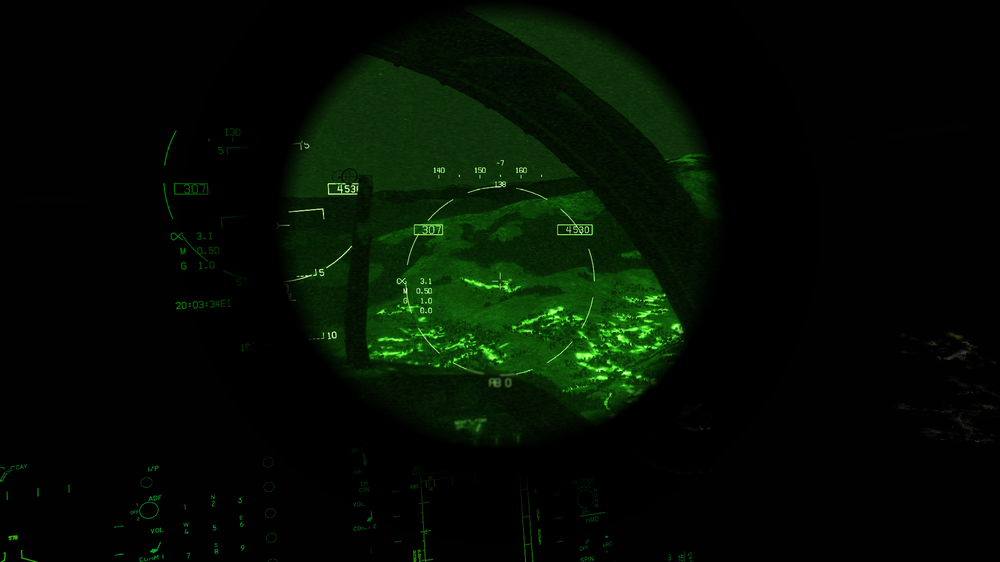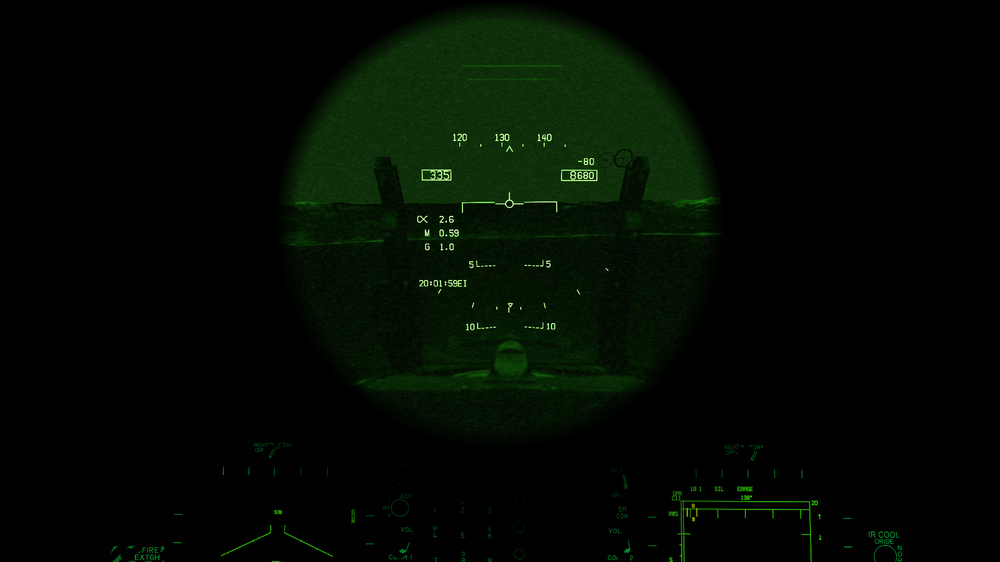

pho3nix
-
Posts
105 -
Joined
-
Last visited
Content Type
Profiles
Forums
Events
Posts posted by pho3nix
-
-
I have noticed that the NVG FOV is variable depending on in-cockpit zoom level rather than a fixed FOV. The JHMCS on the hornet correctly maintains a consistent FOV during in-cockpit zoom. See below:
The NVG FOV should be locked (to about the FOV shown below from experience) to allow easier 'looking under the goggs' for cockpit work, using the MDIs etc...
With this, there should be an option to slew the NVG FOV in the screen FOV (up / down).
Also, JHMCS + NVG might want to be one or the other, not both...
-
The way i have been taught to learn checklists is to say each check in sequence verbatim.
If you got one wrong, stop and start the checklist from the beginning. Do this until you get it perfect.
Where i work i have to learn the normal checklists verbatim as well as the emergency BOLDFACE which is the initial actions (IA's) along with all cautions and warnings associated with the flight manual.
The above method works, trust me, me and every other course before me uses this technique and it does work.
-
The CH gear has 6 throttles dosent it?
I was looking for just the three (throttle, prop, mixture)
-
Love the throttle, i have been looking for one of those but i cant find any.
Hope it comes out within the next 5 months
-
Cheers mate! nice one.
-
Is it possible to change the colour of the smoke (make it lighter)
and make it so it is on permanently without the flame and engine failure?
-
I keep saying this but i still think lockon would be magnificent (more so) if we had these aircraft (yak-52, T-6, L-39) the model is already there for the yak-52, just implementation of advanced prop FM.
on second thoughts, ED does have more important things to do than appeal to my whims... Sorry OT...
Carry on.
-
What aircraft(s) does the russian airforce use in flight school.
In aussie land its: C/T-4B -> P/C-9A -> Hawk Mk 127
with the Hawk being fighter conversion.
Not sure about the US: T-6A -> T-38 ?
Russian: ??? yak-52, l-39 ???
-
Aeroscout, most people seem to be confused about the definition of 'colimated'.
A colimated light beam is one that has a constant spot size along any point of the beem, parallel if you will.
Images in the far field, i.e. objects viewed from a large distance, approximate this criterion.
The human eye operates via this method and 'auto-focuses' the image at 'infinity'.
Therefore if you combine the collimated light beams from the HUD projector with those from out the front of the aircraft far away (such as a target) they will be in the same plane of focus and appear as one image.
That is also the reason why when you move your head, the HUD image seems to be the same size and 'ground stabalised' i.e. self aligning as we can see in the BS movies.
Hope that clears things up and does not confuse things further :p
-
Thats what i have been saying for a long time!!
-
This and the yak-52 (from which it is based?) would be an invaluable addition to this simulator
-
I love flying A2A in the Vanilla and T, just feels more satisfying when you actually manage to place a round on target!
-
Lockonfiles.com
http://lockonfiles.com/modules.php?name=Downloads&d_op=viewdownload&cid=72#cat
Third from the bottom
P.S. I am glad you like the skin, Thanks!
-
Different scores on the officer board depending if they like you or not, no different for aptitude, if thats what you mean.
-
They still do aptitude testing man, not too bad though
-
There has been much talk on these forums of late about the ADF such that this post won't seem too far out of place:smilewink:
I had applied for a RAAF pilot position for a year know and about 6 weeks ago I got my chance at a process called flight screening.
At flight screening, potential applicants are put through their paces at flying and officer skills, essentially a 2 week long flying interview. I went 2 weeks ago and have just come back today.
First of all the flying was very fun and I had a ball with our group of 7 other mates.:thumbup:
Applicants get a score out of 9 for their flying and a score out of 5 for their officer qualities.
I did fairly well at the process and hope to get in soon.
P.S. This isn't an attempt to blow my own horn,:( rather informing a bunch of military aviation enthusuasts about my own journey.:)
-
In hornets they deffinatley use rudder to preform coordinated max-rate rolls.
Most military aircraft have control cross-coupling and mechanical or electronic yaw dampners.
In Lockon when flying the Su-25 (as i guess this thread is about) i allways preform coordinated rolls as the yaw dampner does not compensate enough. It realy helps flying precisley with repeatable results when flying with rudder and TRIMING rudder. In an Su-25 vs. Su-25 BFM, the person flying balanced will ultimatley out turn and out accelerate the other person.
-
Like i have been saying all along...
This is a great time for the RAAF!
-
:0 ! please intergrate into touch buddy!
-
I would like to use this aircraft as a designated traning aircraft, with all aspects of modern military flight demonstrated in game in a traning package.
Although this may not be on the actual aircraft, an in flight refuling probe would make the ultimate!
-
I have seen this effect on tha su-25t movie that was going around, and it is very pronounced on the vihr when looking through the shkval. its looks pretty cool !
-
Force_Feedback is correct in saying that this is all paranoia, but thats the name of the game :)
I agree with both GG and D-Scythe but if Australia did end up getting the F-22, rest assured that every possible section of the aircrafts mission envelope will be taken advantage of.
Thats why the Aussy pilots are the best in the world!
The F-22 isnt requiered but it would be exceptional if acquired :)
TucksonSonny, yes it may appear that Australia is under US pressure, but rest assured, the Super Hornet is the clear winner in this arms race simpley because of unit, operational and most importantley conversion costs.
It made the most sense out of F-15E, EF2000 and the F/A-18 E/F.
I love this thread, no one is personaly attacking anybody, and its great to see many people interested in the fate of Australia's air defences.
Everyone should come down for a holiday :)
-
Once again i agree with you camoman, a single small sqn of F-22's would be ideal, but the real question to this argument is...
Who would win in:
(a) One on one F-35 vs. Su-35 / Mig-25
(b) Many vs. many F-35 vs. Su-35 / Mig-25
I would still bet on the F-35 due to the stealth, mutiple sensors and AMRAAM for (a) (first shot first kill) and networking, sensor fusion and supercruise for (b) (coordinated attack).
-
Briefly I believe, recon role.
Cheers mate, where in aussy are u?




Fixed FOV NVG
in Wish List
Posted
https://forums.eagle.ru/forum/english/digital-combat-simulator/dcs-world-2-5/bugs-and-problems-ai/general-questions-ac/231403-nvg-field-of-view-issues
I asked for this ages ago but nothing...